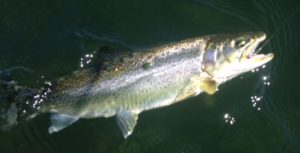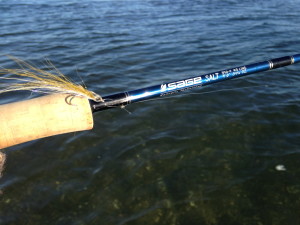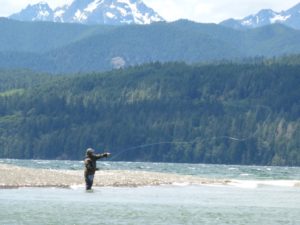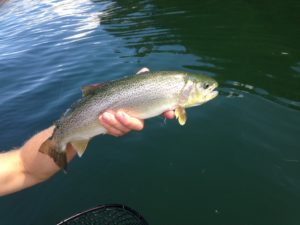
We are half way through September and Puget Sound and Hood Canal Sea-Run Cutthroat are really starting to take on their fall harvest colors. Deeply toned and pronounced spots, yellow bellies and yellow tipped fins, and those bright red cutthroat stripes under their gill plates all point towards one thing for these fine wild trout – spawning. If you are new to the sport of chasing these wily game fish on a fly – September and October are definitely the time to pursue them in the saltwater.
Anglers new to the sport of fly fishing for Sea-Run Cutthroat will find some of the Northwest’s finest weather. Yes, we get a low pressure system here and there in Western Washington, but overall we find cool, crisp days with temperatures tapping the 70 degree mark – perfect for that angler looking to get out prior to the heavy rains of November.
The nice part about this fishery is that anglers can literally transition their stream and lake gear right into Sea-Run Cuttthroat fishing on Hood Canal and Puget Sound. Pack those waders, rods, reels and a handful of Sea-Run Cutthroat flies and you have the makings of a SRC angler.
Fly Rod – The perfect rod for pursuing SRC really is a 6-weight, especially if you are in an area where you might tie into a Coho salmon. However, if I was to pick one rod to pursue SRC specifically, it would be a 5-weight. A 5- weight is heavy enough to fight a little wind and light enough that a 12 inch SRC gives you a battle and a fun time. The best rod I have ever casted for SRC, is the Sage Salt 590. Powerful and smooth, this rod is awesome.
weight is heavy enough to fight a little wind and light enough that a 12 inch SRC gives you a battle and a fun time. The best rod I have ever casted for SRC, is the Sage Salt 590. Powerful and smooth, this rod is awesome.
However, any rod you have in your arsenal ranging from a 4-7 weight will work. It’s more about an anglers casting ability and being to get the line into the right zone where the fish are. Casting ability, and being able to throw a line atlas in the range of 30-40 feet or further will drastically increase your chances of hook ups – especially if you are fishing from the beach.
Fly Line – the perfect line is really dependent on what type of beach you are fishing. I have different lines on tap to include floating, intermediate and also a tapered sinking line by Scientific Anglers called their Sonar Titan rigged and ready to go on my boat. If I had to choose just one line though it would be an intermediate. This line style sinks slow enough for a wading angler with a stripping basket to retrieve the line without it dragging in the rocks, but also gets down into the water column at a slow sink rate of 1-1.25 inches per second for those sharper ledges. Need more depth, anglers can just let it sink longer. Sometimes, while boat fishing, I will let the line sink upwards of 20 seconds to achieve the proper depth. Rio fly lines new Coastal Quickshooter in a full intermediate is newly redesigned this year and a great line.
Stripping Basket – definitely a game changer here, and the serious beach angler needs one to efficiently and effectively cast without your line getting all tangled in the rocks. Check out this video by Red’s Fly Shop on the benefits on using a stripping basket.
Fly Reels – It really doesn’t matter as long as it is in working order and a has a decent drag, and you rinse it with fresh water after each use and let it dry out. Quality reels with sealed drag systems will last much longer, but my personal preference is to go with reels that are middle of the road. The Sage 2200 series is an awesome reel for the money, and is what I fish on my Sage 590 Salt.
Flies – the cool part about this fishery is that Sea-Run Cutthroat “generally” aren’t super picky. It is more of locating and finding the fish then it is actually trying to match the hatch. However, they definitely do want a fly that resembles something in the general area of what they eat. So, it they are eating herring – a general baitfish pattern will do the trick. Closer minnows in olive and chartreuse are also staple patterns – particularly ones with red eyes. A variation of sculpins is also a mainstay for Sea-Run Cutthroat, as they prey heavily on these particularly during the winter months. Certain times of the year provide certain food sources, and these vary based on where anglers are fishing. If you are fishing Hood Canal in the winter, then you would want to be fishing sculpin or shrimp variations. Puget Sound during May and June – you can’t beat a sand lance pattern.
Where to Start Fishing? – Locating beaches that have active and willing Sea-Run Cutthroat is the key element for  anglers to achieve success. What I look for in a quality beach is a point of land, some current, bottom structure and a decent pitch to the beach. These elements I nick named the “The Beach Quadfecta” and they serve as general
anglers to achieve success. What I look for in a quality beach is a point of land, some current, bottom structure and a decent pitch to the beach. These elements I nick named the “The Beach Quadfecta” and they serve as general
starting point for new anglers. Oyster beds and eel grass will also serve as SRC hang outs at certain times. As an angler new to the game of SRC fishing, the key is to keep moving beaches throughout the day until you locate fish. Twenty-five minutes is how long I fish a beach, and if I haven’t seen jumpers or hooked any fish I move on to the next spot. SRC are elusive at times, and what was hot fishing yesterday can be an epic slow day the next day.
Anglers should use a journal and log tides, weather, beach structure and anything else witnessed that might help to increased success in the future. Over time, anglers new to this SRC game will begin to identify good looking beaches, and when a beach will “set up” perfectly during a tide cycle.
Contact us to schedule a day on the water.
Capt. Chad Gillespie Fjord Fly Fishing
www.fjordflyfishing.com
chad@fjordflyfishing.com
Hood Canal and Puget Sound Guided Fly Fishing Adventures
